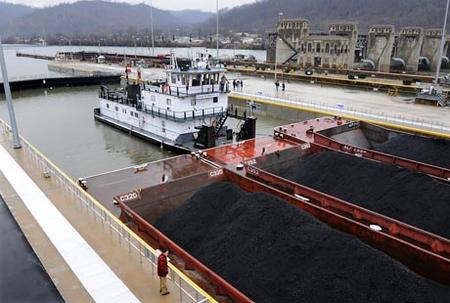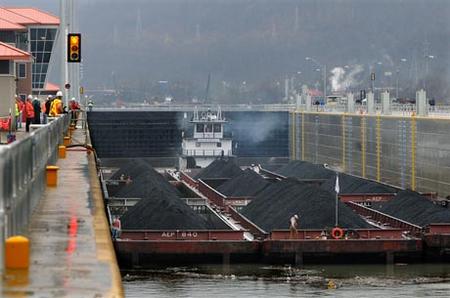
Charleston Gazzette
23 January 2008
By Sarah K. Winn, Staff writer
It was cold, icy and raining as workers opened the new Marmet Lock and Dam to traffic for the first time Tuesday, and that was fine with some people.
"It's a good day for showing the safety aspect [of the new lock]," said Col. Dana R. Hurst, commander of the Army Corps of Engineers in Huntington.
In the old lock, workers would have to unhook each barge as it traveled through the lock, scaling slippery walls and tying icy cables, he said.
"If this would have been icy ... you can see how dangerous it would be," he said, pointing to the new platform. "Now, a boat just comes in and goes."
On Tuesday, the 110-foot-by-800-foot lock chamber officially opened for use. The MV Lawson W. Hamilton Jr. towboat was the first boat to push barges through it.

The MV Lawson W. Hamilton Jr. towboat gets ready to push coal barges through the new Marmet Lock. - Photographer: Chris Dorst
"This will be a lot safer ... now, we donft have to go through the motions," said Jodey Keiffer, the main captain of the boat. Keiffer, who wasn't driving the boat on Tuesday because it was his day off, has been steering the Lawson for eight years, pushing coal barges for Madison Coal and Supply.
Ryan Groves, a deckhand on the boat, agreed.
"No more climbing walls or pushing barges through," he said while standing atop one of the barges. "This is it."
The boat was pushing about $1 million in coal, Keiffer estimated.
The new lock replaces the 56-foot-by-360-foot lock chamber, built in 1934 for $3.6 million.
It would take five hours for five barges to pass through the old lock, Hurst said. Now, nine full barges can pass through in about 45 minutes.
That saved time means saved money for consumers, Hurst and others emphasized.
"At the end of the day, it really benefits the consumer," said David K. Smith, president of the Huntington District Waterways Association. "acilities like this help keep the costs down."

The new lock can pass nine barges through in 45 minutes, Army Corps of Engineers officials said. - Photographer: Chris Dorst
In 2007, more than 16 million tons of commodities, including 15 million tons of coal, passed through the lock. The lock averages about 60 cycles a day.
Last week, the Corps of Engineers began testing the new lock chamber. The old lock chamber will be used as a backup during scheduled maintenance.
While the new lock is open for river traffic, more work needs to be done to complete the project. That includes demolition of the old approach walls, construction of an upstream guard wall, final grading, replanting of the construction site and completion of recreation areas including fishing access.
The rest of the work will be complete by September 2009, Hurst said.
Coy Miller, deputy district engineer for programs and project manager for the new lock, has been working on the riversf locks and dams system since he was a student at the West Virginia Institute of Technology in 1981.
Tuesday was the end of a long journey, he said. "It's like seeing something come to completion," he said. "It's exciting."
Despite the joy, Miller was still a little cautious.
"I heard that thumping and banging and it scared me for a minute," he said to a fellow engineer. "But that's just the old chamber."
To contact staff writer Sarah K. Winn, use e-mail or call 348-5156.